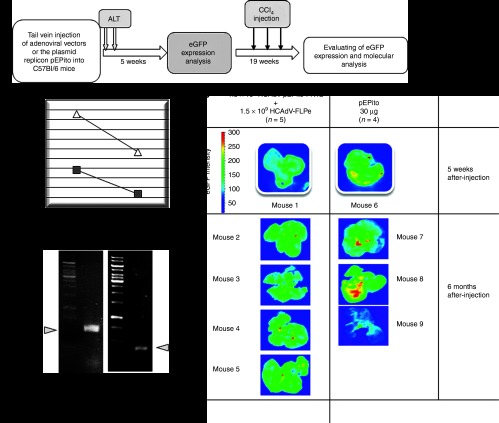Figure 6.
Evaluation of the adenovirus/pEPito hybrid-vector system in vivo. The adenoviral vector HCAdV-pEPito-FRT2 (1.5 × 109 transducing units) was coinjected with the FLPe-encoding virus HCAdV-FLPe (1.5 × 109 transducing units) into C57BL/6 mice (n = 5 per group). As a direct comparison, 30 µg of the plasmid replicon pEPito51 were administered using hydrodynamic injection via the tail vein into C57BL/6 mice (n = 4 per group). ALT, alanine aminotransferase levels; CCl4, carbon-tetrachloride; eGFP, enhanced version of green fluorescent protein. (a) Outline of the experimental approach. (b) To evaluate liver toxicity, alanine aminotransferase (ALT) levels were measured 1 and 7 days after injection. Normal levels for mice range from 20 to 80 international units per liter (IU/l). Plasmid injected mice (triangle) and adenovirus infected mice are shown (square). Mean values of the viral approach (n = 5) and the plasmid approach (n = 4) are shown. (c) Analysis of eGFP expression 5 weeks after injection (one exemplary mouse is shown for each setup) and 6 months after adenovirus administration and three sequential carbon-tetrachloride (CCl4) injections for induction of rapid cell cycling in murine liver. For the adenovirus injected group 4 mice (mouse 1–4) are shown and for the plasmid injected group 3 mice (mouse 1–3) are shown. Whole organs were analyzed for eGFP expression. (d) The plasmid replicon pEPito-FRT can be released from the adenoviral vector genome in vivo. The excision PCR described in Supplementary Figure S5 was performed to detect the excised plasmid replicon in the group that received the adenoviral vector and for detection of the plasmid replicon pEPito. Amplification product for pEPito-FRT presents with bigger size compared with pEPito because of added FRT site during recombination process with FLPe.

